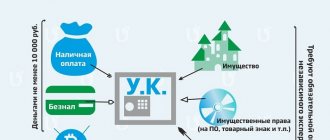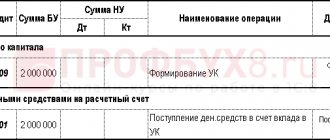Accounting
The founder reflects his contribution to the authorized capital of other organizations in account 58 “Financial investments”. You can use account 76 to reflect settlements with a subsidiary, or you can immediately reflect all settlements on account 58 without using account 76.
Debit 58.1 Credit 76 subaccount “Settlements on contributions to the authorized capital” - reflects the debt on the contribution to the capital of another organization.
The disposal of a fixed asset and its transfer to the management company is reflected as follows:
Debit 01 subaccount “Disposal of fixed assets” Credit 01
– the original (replacement) cost of the fixed asset is written off.
Debit 02 Credit 01 subaccount “Disposal of fixed assets”
– the amount of accrued depreciation is written off.
Debit 76 subaccount “Calculations for contributions to the authorized capital” Credit 01 subaccount “Disposal of fixed assets” or Debit 58.1 Credit 01 subaccount “Disposal of fixed assets” - reflects the transfer of an asset as a contribution to the authorized capital (at residual value).
If the residual value of the fixed assets does not coincide with the assessment of the founders, then the difference is taken into account as part of other income or expenses.
Debit 76 subaccount “Settlements on contributions to the authorized capital” Credit 91.1
or
Debit 58.1 Credit 91.1 - reflects the positive difference between the assessment of the fixed assets agreed upon by the founders and its residual value.
Debit 91.2 Credit 76 subaccount “Settlements for contributions to the authorized capital”
or
Debit 91.2 Credit 58 - reflects the negative difference between the assessment of the fixed assets agreed upon by the founders and its residual value.
Documenting
Receipt of a fixed asset must be formalized with a primary document, which must contain the mandatory details provided for in Part 2 of Article 9 of the Law of December 6, 2011 No. 402-FZ. Such a document, for example, may be an act in form No. OS-1a or in form No. OS-1. For more information on preparing primary documents, see How to manage document flow in accounting.
Fill out the act in form No. OS-1 at the time of receipt of fixed assets (except for buildings and structures) (paragraph 2 of the instructions approved by Resolution of the State Statistics Committee of Russia dated January 21, 2003 No. 7, Part 3 of Article 9 of the Law of December 6, 2011 No. 402-FZ).
If the founder took into account the contributed property as a fixed asset, draw up an act in form No. OS-1 in the same way as when receiving fixed assets for payment. In this case, the founder will act as the transferring party, and the organization will act as the receiving party. The rules for filling out the act for fixed assets acquired for a fee should also be applied in the case where the founder accounted for the contributed property as a commodity.
In any case, in the act in form No. OS-1, indicate:
- number and date of drawing up the act;
- full name of the fixed asset according to the technical documentation;
- name of the manufacturer;
- place of acceptance of the fixed asset;
- factory and assigned inventory numbers of the fixed asset;
- depreciation group number and useful life of the fixed asset;
- information about the content of precious metals and stones;
- other characteristics of the fixed asset.
In addition, the act must contain the conclusion of the acceptance committee (for example, the entry “Can be used”). The executed act is approved by the head of the organization.
When receiving buildings and structures as a contribution to the authorized capital, fill out the act in form No. OS-1a. If an organization receives several homogeneous fixed assets, draw up an act in form No. OS-1b. When filling out these acts, use the same procedure as when drawing up an act in form No. OS-1.
Such rules are established by instructions approved by Resolution of the State Statistics Committee of Russia dated January 21, 2003 No. 7.
Situation: how to register the receipt of fixed assets contributed by the citizen founder as a contribution to the authorized capital?
Upon receipt of a fixed asset (except for buildings and structures), draw up an act in form No. OS-1 (paragraph 2 of the instructions approved by Resolution of the State Statistics Committee of Russia of January 21, 2003 No. 7, Part 3 of Article 9 of the Law of December 6, 2011 No. 402-FZ).
Draw up an act on the basis of shipping documents (instructions approved by Resolution of the State Statistics Committee of Russia dated January 21, 2003 No. 7). Since there are no standard documents for registering property received as a contribution to the authorized capital from citizens, you can draw up an act in any form.
Use the same procedure if you fill out:
- form No. OS-1a - upon receipt of the building (structure);
- Form No. OS-1b - upon receipt of a group of fixed assets of the same type.
The details of the donating organization, which are provided at the beginning of the form, do not fill out the sections “Information on the condition of the fixed asset object on the date of transfer” and “Passed over”. This is explained by the fact that citizens should not draw up acts in form No. OS-1 (clause 2 of the resolution of the State Statistics Committee of Russia dated January 21, 2003 No. 7, letter of Rosstat dated March 31, 2005 No. 01-02-09/205).
Firstly, they are not legal entities. And secondly, the property that a citizen transfers to an organization is not his main asset.
Simultaneously with drawing up an act in form No. OS-1 (OS-1a, OS-1b) for each object (group of objects) of the fixed asset, fill out an inventory card in form No. OS-6 (OS-6a) or an inventory book in form No. OS- 6b (intended for small businesses). Fill out the inventory card (book) in one copy based on the data from the act and accompanying documents (for example, technical passports). In the future, enter information into the card (book) about all changes that affect the accounting of fixed assets (revaluation, modernization, internal movement, disposal). Enter information on the basis of relevant documents (for example, an acceptance certificate for modernized fixed assets in form No. OS-3, invoice for internal movement in form No. OS-2).
This procedure follows from the instructions approved by Resolution of the State Statistics Committee of Russia dated January 21, 2003 No. 7.
When registering a receipt as a contribution to the authorized capital of fixed assets, take into account the features that are associated with receiving property that requires installation and (or) state registration.
Attention: the absence (failure to submit) primary documents for accounting for fixed assets is an offense (Article 106 of the Tax Code of the Russian Federation, Article 2.1 of the Code of Administrative Offenses of the Russian Federation), for which tax and administrative liability is provided.
If an organization receives a fixed asset containing precious metals, at the end of the year it will have to draw up a report according to Form No. 4-DM, approved by Rosstat Resolution No. 88 of November 14, 2007. In the report, indicate the amount of precious metals contained in the fixed asset.
Tax accounting
VAT
VAT is not charged on fixed assets transferred to the authorized capital, since this operation is not recognized as a sale.
Input VAT on fixed assets, previously accepted for deduction, must be restored. But not all, but a part proportional to the residual value of the OS.
Debit 19 Credit 68 subaccount “Calculations for VAT” – VAT on fixed assets transferred as a contribution to the management company has been restored;
The transferring party includes the recovered VAT in the initial cost of the financial investment.
Debit 58.1 Credit 19 – restored VAT is reflected as part of financial investments.
The receiving party can accept the restored VAT as a deduction.
Income tax
When transferring property to the authorized capital of organizations, no income or expenses arise.
A loss from the contribution of fixed assets to the authorized capital of another organization does not reduce the taxable profit of the organization. If the residual value differs from the agreed valuation of the founders, then permanent differences arise.
The positive difference between the residual value and the founders’ assessment forms a permanent tax asset:
Debit 68 subaccount “Calculations for income tax” Credit 99 subaccount “Permanent tax assets”.
The negative difference between the residual value and the founders’ assessment forms a permanent tax liability:
Debit 99 subaccount “Fixed tax liabilities” Credit 68 subaccount “Calculations for income tax”.
We receive fixed assets into the authorized capital
Today, the size of the authorized capital of a limited liability company at the time of its creation must be at least 10,000 rubles. In the future, to ensure an attractive balance sheet and solidity of the business, company participants may decide to increase the authorized capital. One way to make this change is for participants to provide additional input. The legal registration and accounting of this operation, using the example of the transfer of a fixed asset, as well as the nuances of taxation, will be discussed in our article.
We make a decision
The issue of changing the authorized capital can only be decided by a general meeting of participants. Additional contributions are made by the company's participants within two months from the date the general meeting makes a decision to increase the authorized capital, unless a different period is established by the charter or the decision of the general meeting of the company's participants. Then, no later than a month from the end of this period, a general meeting of LLC participants must be convened, at which the results of the increase in the authorized capital are approved. In case of failure to comply with this deadline in accordance with paragraph 1 of Art. 19 of Federal Law No. 14-FZ of 02/08/1998, the increase in the authorized capital of the company will be recognized as failed.
Each participant in the company has the right to make an additional contribution not exceeding part of the total cost of additional contributions, proportional to the size of the share of this participant in the authorized capital of the company. The deposit may be money, securities, other things or property rights or other rights that have a monetary value.
So, the decision has been made, the method has been chosen, additional contributions have been made. Now it is necessary to make changes to the constituent documents of the company.
Registering changes
Information about changes in the size of the authorized capital is reflected in the company's charter. The memorandum of association is the first agreement of a company at the time of its formation. It remains unchanged throughout the entire period of society's existence.
The new version of the charter is subject to mandatory state registration. The authorized federal executive body carrying out state registration is the Federal Tax Service of the Russian Federation. Thus, to register changes made to the constituent documents, it is necessary to contact the authorized territorial tax authority.
Clause 5 of Art. 5 of the Federal Law of 08.08.2001 No. 129-FZ “On State Registration of Legal Entities and Individual Entrepreneurs” for submitting documents to the registration authority establishes a three-day period from the date of changes.
However, the Ministry of Taxes and Taxes of Russia, in Letter No. 09-1-02/4040-AV409 dated August 14, 2003, indicated that this period does not apply to the submission of information related to amendments to the constituent documents. According to the Ministry of Taxes and Taxes of the Russian Federation, the period for registering such changes is not established by Federal Law No. 129-FZ dated 08.08.2001. Therefore, if the organization does not meet the three-day deadline, then liability in the form of a warning or a fine of 50 minimum wages for late submission of information about a legal entity to the registration authority, provided for in paragraph 3 of Art. 14.25 of the Code of Administrative Offenses of the Russian Federation, should not be applied.
Please note that the deadline for registering an increase in the authorized capital due to additional contributions is provided for in paragraph. 4 paragraphs 1 art. 19 of the Federal Law of 02/08/1998 No. 14-FZ. The company is obliged to notify the registration authority within one month from the date of the decision to approve the results of making additional contributions to the authorized capital by the company's participants. In case of failure to comply with the deadline for registering changes in the constituent documents, the increase in the authorized capital of the company will be recognized as failed (Clause 1, Article 19 of the Federal Law of 02/08/1998 No. 14-FZ).
For registration, you must submit notarized documents to the tax authority: 1. Application for state registration of changes made to the constituent documents of a legal entity in the form P13001 (Resolution of the Government of the Russian Federation of June 19, 2002 No. 439). The notary certifies only the first three pages of this application. 2. The decision of the company's participants on the results of increasing the authorized capital and on making changes to the constituent documents. 3. The text of amendments to the charter or the company’s charter in a new edition. 4. Receipt for payment of state duty. In practice, the tax authorities require the original of this receipt to be presented, which is then returned along with the registered changes to the constituent documents. The fee is 400 rubles. (Clause 3, Clause 1, Article 333.33 of the Tax Code of the Russian Federation).
In addition, if the authorized capital is increased due to additional contributions from participants, then in order to register the changes, you must submit a document confirming payment of the contribution to the authorized capital.
The applicant must submit documents for registration in triplicate. One copy remains with the tax authority, the second (with the registration stamp) is returned to the LLC, the third copy of the new version of the charter will need to be presented to the bank.
We reflect the increase in authorized capital in accounting and tax accounting
When the founders make non-monetary contributions to the authorized capital, their monetary value is approved by a decision of the general meeting of company participants, adopted unanimously by all company participants. If the nominal value of a company participant’s share in the authorized capital, paid for by a non-monetary contribution, is more than 200 minimum wages established by federal law on the date of submission of documents for state registration of the relevant changes (today – 20,000 rubles), such a contribution must be assessed by an independent appraiser. Moreover, the nominal value of the share of a company participant, paid for by a non-monetary contribution, cannot exceed the amount specified by an independent appraiser.
In accounting, a fixed asset received as a contribution to the authorized capital of a company is taken into account at its cost, which is its monetary value agreed upon by the founders, unless otherwise provided by the legislation of the Russian Federation.
Payment by the founder of an additional contribution to the authorized capital of the company by making a fixed asset is reflected in accounting in the following order: D-t 08-4 K-t 75 - an additional contribution to the authorized capital was received in the form of a fixed asset at the cost agreed by the founders (excluding VAT) .
Dt 75 Kt 80 – reflects the increase in the authorized capital of the company.
The founder - a legal entity, transferring property as a contribution to the authorized capital of the company, is obliged to restore the amount of VAT on it, which he had previously legally accepted for deduction. For fixed assets and intangible assets, VAT is restored in an amount proportional to the residual (book) value (excluding revaluation). The peculiarity of registration of such a transfer is that the transferring party indicates the amount of the restored value added tax directly in the transfer and acceptance certificate, that is, without drawing up an invoice. In this case, the restored amounts of VAT are not included in the cost of the property received, but are subject to deduction from the receiving party after it is registered in the manner established by Chapter. 21 Tax Code of the Russian Federation.
The received VAT amount, according to the Ministry of Finance of the Russian Federation, is reflected separately in the additional capital account (Letter of the Ministry of Finance of the Russian Federation dated October 30, 2006 No. 07-05-06/262):
D-t 19 K-t 83 – reflects the received amount of VAT, restored by the founder (legal entity) to the budget upon transfer of the fixed asset, specified in the transfer and acceptance certificate. D-t 01 K-t 08-4 – fixed asset accepted for accounting. D-t 68 K-t 19 – accepted for deduction of VAT on fixed assets received as an additional contribution to the authorized capital on the basis of documents documenting the transfer of fixed assets.
Thus, the Ministry of Finance of the Russian Federation clarified the accounting procedure. As for income tax, income received in the form of contributions to the authorized capital of an organization is not taken into account for tax purposes.
At the same time, for the fixed assets received as part of the authorized capital, depreciation for the purposes of Ch. 25 of the Tax Code of the Russian Federation is accrued in the general manner, which means that the receiving party must determine the value of this property.
Income is determined on the basis of primary documents and other documents confirming the income received by the taxpayer, and tax accounting documents (clause 2, clause 1, article 248 of the Tax Code of the Russian Federation).
The procedure for determining the value of property received as a contribution is established by Art. 277 Tax Code of the Russian Federation. Thus, in accordance with this article, the fixed asset contributed to the authorized capital is accepted at its residual value, reflected according to the tax accounting data of the transferring party.
Do the provisions of Art. 170, 251, 277 of the Tax Code of the Russian Federation, as well as the above recommendations of the Ministry of Finance of the Russian Federation on reflecting the transaction in question in accounting, to conclude that the transaction is completed and fully reflected for both accounting and tax accounting purposes?
Official's opinion
At the request of the editors, the head of the Income Tax Administration Department of the Federal Tax Service of the Russian Federation, Advisor to the Tax Service of the Russian Federation of the 2nd rank, Oleg Davydovich Khoroshy, commented on the taxation procedure for this operation: “The restored amount of VAT cannot form the initial cost of property received as a contribution to the authorized capital. Consequently, obtaining the right to deduct VAT amounts without actually incurred expenses should be characterized as receiving an economic benefit, leading to an increase in capital. Therefore, the conclusion of the Ministry of Finance in the commented letter is not entirely clear to me.
As for the procedure for taxing this deduction from an organization that has received this right, I think it is possible to classify the receipt of this benefit as a gratuitous receipt of a property right to the possibility of demanding a certain amount from the budget. Therefore, this amount should be reflected in non-operating income. Indeed, the Ministry of Finance did not express its position on the issue of taxation of this amount.”
Readers' opinion
There is no economic benefit for the recipient
Receiving equipment as a contribution to the authorized capital of an organization is a fairly common practice. In the recipient's accounting, the initial cost of such equipment is determined as its cost, agreed upon by the founders, minus the amount of VAT subject to deduction in accordance with tax legislation. Officials of the Ministry of Finance are absolutely right that the amount of VAT goes to increase the additional capital of the organization.
As for the questions of whether the receiving party has an economic benefit and whether it should be included in non-operating income, then, in our opinion, the recipient does not have it, since VAT is charged by the transferring party and is accepted for deduction by the receiving party in the manner established by Chapter . 21 Tax Code of the Russian Federation. Also, the lack of income from the issuer is indicated by clause 1 of Art. 277 Tax Code of the Russian Federation.
In addition, the value of property in accounting and tax accounting differs. Therefore, when preparing financial statements, do not forget about the need to apply PBU 18/02.
Anna Smirnova, deputy General Director for Audit Activities, St. Petersburg
VAT from the budget is not a civil legal relationship
It is difficult to agree with the conclusion that the right to deduct VAT amounts in the described situation is a gratuitous receipt of the property right to the ability to demand certain amounts from the budget and the corresponding recognition of this amount as non-operating income. The thing is that there is a difference in the nature of the relationships that arise in the field of taxation and in ordinary contractual relations.
First of all, the obligation to pay taxes (Article 57 of the Constitution of the Russian Federation) is of a public law, and not a civil law nature (Resolution of the Constitutional Court of the Russian Federation of December 17, 1996 No. 20-P).
It should also be taken into account that the organization participates in tax legal relations not at its own discretion, but in accordance with the responsibilities specified in the Tax Code of the Russian Federation.
Thus, the right to demand the return of funds from the budget is secondary to the need to fulfill tax obligations and is of an administrative, but not civil, nature. The Tax Code does not contain the concept of property rights in Chapter. 25, nor in the first part. In this regard, property rights can only be interpreted on the basis of civil legislation (Article 11 of the Tax Code of the Russian Federation).
Based on the above and taking into account the established paragraph 3 of Art. 2 of the Civil Code of the Russian Federation, the restriction according to which civil legislation does not apply to property relations based on the administrative subordination of one party to the other, including tax relations, the conclusion about the gratuitous nature of VAT amounts reimbursed from the budget in this situation seems unfounded.
Vyacheslav Serov, lawyer
As you can see, there is currently no clear opinion on this issue. The country's main financial department has not yet sent any official explanations.
Attention! Read about increasing the authorized capital of a limited liability company by contributing funds from participants, attracting contributions from new participants, and using the company’s property in the upcoming issues of the magazine.
) clause 1 art. 14 of the Federal Law of 02/08/1998 No. 14-FZ “On Limited Liability Companies”), paragraphs. 2 p. 2 art. 33 of Federal Law No. 14-FZ) clause 1 art. 19 Federal Law No. 14-FZ) clause 1 art. 15 of Federal Law No. 14-FZ) clause 4, 7, 9 PBU 6/01) clause 3 art. 170 of the Tax Code of the Russian Federation) clause 11 of Art. 171, paragraph 8 of Art. 172, paragraph 3 of Art. 170 Tax Code of the Russian Federation) paragraphs. 3 p. 1 art. 251 Tax Code of the Russian Federation
Case Study
Medea LLC contributed a laptop to the authorized capital of Les LLC. The agreed monetary value of the founders is 40,000 rubles.
The initial cost of the laptop is 76,700 rubles. (including VAT - 11,700 rubles). The amount of accrued depreciation is RUB 32,500.
Solution:
- Debit 01 subaccount “Disposal of fixed assets” Credit 01 - 65,000 rub. (76,700 - 11,700) - the initial cost of the laptop has been written off.
- Debit 02 Credit 01 subaccount “Disposal of fixed assets” - 32,500 rubles. — accrued depreciation is written off.
- Debit 58.1 Credit 01 subaccount “Disposal of fixed assets” - 32,500 rubles. (65,000 - 32,500) - the residual value of the laptop has been written off.
- Debit 19 Credit 68 - 5,850 rub. ((32,500: 65,000) x 11,700) — VAT has been restored.
- Debit 58.1 Credit 19 - 5,850 rub. the restored VAT is taken into account as part of financial investments.
- Debit 58.1 Credit 91.1 - 7,500 rub. (40,000 - 32,500) - reflects the positive difference between the founders’ assessment and the residual value of the laptop.
- Debit 68 Credit 99 - 1,500 rub. (7,500 x 20%) - a permanent tax asset is reflected.
Basic entries used for authorized capital
When founding an enterprise, the initial operation in accounting. accounting should be the transfer by participants of their parts to the authorized capital of the company. Such an action is reflected in account 80 “Authorized capital”, which can, under certain circumstances, either increase or decrease.
As for analytical accounting for accounts. 80, then it is carried out in the context of each participant, that is, in this account you can always view information about which of the founders and in what volume invested funds for the company’s activities. In addition, the account can also provide information on what stages of capital formation were previously, and how it changed over time.
Contribution to uk main means of posting
Tax amounts are subject to restoration in the amount previously accepted for deduction, and in relation to fixed assets and intangible assets - in the amount proportional to the residual (book) value without taking into account revaluation.
3. Amounts of tax accepted for deduction by the taxpayer on goods (work, services), including fixed assets and intangible assets, property rights in the manner prescribed by this chapter, are subject to restoration by the taxpayer in the following cases:
Step-by-step instruction
Attention! The VAT rate has been changed from 01/01/2019 from 18% to 20% and from 18/118 to 20/120.
Success LLC is established. In accordance with the constituent agreement, shares in the management company are distributed as follows:
- 20% founder Pushkarev A.S.;
- 80% founder of Pegasus LLC.
On January 11, the state registration of the Company in the Unified State Register of Legal Entities took place.
On January 18, the founder of Pegasus LLC makes a contribution to the management company with property. A used OS Server INTEL R1304WT2GSR at a cost of RUB 120,000 agreed upon by the founders. This value was confirmed by an independent appraiser (remaining SIP - 25 months). The founder of Pegas LLC restored input VAT in the amount of 19,350 rubles. on the transferred OS and highlighted it in the transfer and acceptance certificate in the OS-1 form.
Let's look at step-by-step instructions for creating an example. PDF
| date | Debit | Credit | Accounting amount | Amount NU | the name of the operation | Documents (reports) in 1C | |
| Dt | CT | ||||||
| Payment of a share in the management company with a property contribution (OC) | |||||||
| January 18 | 08.04.1 | 75.01 | 120 000 | Receipt of a non-current asset on account of the contribution to the management company (manual adjustment of the value in the management company) | Receipt (act, invoice) - Equipment | ||
| 19.01 | 83.09 | 19 350 | Acceptance of VAT accounting (manual adjustment of account 75.01 to 83.09) | ||||
| 01.01 | 08.04.1 | 120 000 | OS commissioning | Acceptance for accounting of fixed assets - Equipment | |||
| Registration of PUD for obtaining the right to deduct VAT | |||||||
| January 18 | — | — | 120 000 | Registration of the primary document received from the founder (instead of the SF) | Invoice received for receipt | ||
| Acceptance of VAT for deduction on fixed assets entered into the Criminal Code | |||||||
| January 18 | 68.02 | 19.01 | 19 350 | Acceptance of VAT for deduction | Generating purchase ledger entries | ||
| — | — | 19 350 | Reflection of VAT deduction in the Purchase Book | Purchase Book report | |||
| Depreciation calculation | |||||||
| 28th of February | 26 | 02.01 | 4 800 | Depreciation calculation | Closing the month - Depreciation and amortization of fixed assets | ||
For the beginning of the example, see the publication:
- Formation of a management company in an LLC
Formation of authorized capital: accounting entries
The increase in the authorized capital is carried out at the expense of net assets, additional and contributions from third parties. It is allowed to use several sources simultaneously. Let's look at how the formation of the authorized capital is displayed; we won't ignore the entries in the accounting system either.
The authorized capital is the amount that the founders contribute after registering the company. It is displayed in the liability side of the balance sheet, since it is the source of the formation of assets. The founders can make contributions in the form of cash, non-cash funds, materials, fixed assets. The activities of the enterprise are financed from the funds of the management company.
Postings on deposits in the management company
A gross violation by an organization of the rules for accounting for income and (or) expenses and (or) taxable items, if these acts were committed during one tax period, in the absence of signs of a tax offense provided for in paragraph 2 of this article, entails a fine in the amount of five thousand rubles.
28. Upon receipt of a contribution to the authorized (share) capital of an organization in the form of fixed assets, an entry is made in the debit of the account for accounting for investments in non-current assets in correspondence with the account for accounting for settlements with the founders.
Contribution to uk main means of posting
- on introducing amendments to the company's charter related to increasing the size of the authorized capital;
- on the increase (determination) of the nominal value of the share of a participant (shares of participants) of the company or the share of a third party (third parties) who submitted applications for making a contribution (contributions);
- on changing (determining) the size of shares of company participants or a third party (third parties).
The question arises - how to reflect in the Balance Sheet of an LLC the value of money and other property received from participants in connection with an increase in the size of the authorized capital before registering changes in the Unified State Register of Legal Entities? That is, the founders have already made contributions, but the registration of the corresponding changes in the constituent documents has not yet occurred. In this case, investments should be shown as a separate item in Section III “Capital and Reserves” of the Balance Sheet.
We recommend reading: Are Debts Transferred by HOAs?
Contribution to uk main means of posting
The legislation allows payments to the management company both in money and in property or property rights. On the date of making the contribution (the full amount or part thereof), both the founder and the legal entity established by him are repaid the corresponding part of the existing debt.
Commercial legal entities (PJSC, JSC, LLC, business partnerships, state unitary enterprises, municipal unitary enterprises) are created with the mandatory formation of an authorized capital (MC). The size of the management company, the share of participation in it of each of the founders, payment terms, form of contributions and assessment of non-monetary contributions are stipulated in the constituent agreement.
Topic: Postings on deposits in the management company
The contribution to the management company was made with a laptop worth 19,000 rubles. formed the posting trail: DT - KT 75 - 80 08 - 75 01 - 08 02 - 01 20 - 02 90 - 02 99 - 90 and accordingly my balance will show the amount on account 80 and the loss on account 84. correct me. if something is wrong?!
That’s right, my goal is to formalize the entries for the acceptance of the oil and gas reserves in the management company can then be like this: 75 - 80 - The founder’s debt for the formation of the authorized capital is reflected 10 - 75 - The laptop is accepted as a contribution to the authorized capital 20 - 10 - the laptop is put into operation, its cost written off as expenses at a time right? What other wiring is needed?!
Contribution to property posting
In a situation of acute shortage of funds, a company often practices interest-free loans from its participants, which are possible regardless of the legal status of the lender and borrower, as well as the ratio of shares of the organization’s founders. The main disadvantage of the loan agreement is that the transferred funds must be returned to the lender, however, in the absence of an obligation to pay interest, even temporary receipt of funds significantly facilitates the financial situation. In addition, “partnership” loan agreements establish a long loan repayment period, and it can be increased as necessary through additional agreements if the financial condition of the borrowing company has not improved.
So, the gratuitous transfer of funds is ideal for the case when financial assistance is provided by a founder (participant) who is an individual and owns more than 50% of the company. This option can be called “risk-free”.






